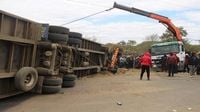In a tragic incident that has shaken northeastern Zimbabwe, a head-on collision between a minibus taxi and a haulage truck claimed the lives of 17 people on Tuesday, July 22, 2025. The accident occurred near Chitungwiza, a densely populated satellite town located approximately 25 kilometers southeast of the capital city, Harare. According to police spokesman Paul Nyathi, all victims, including two pedestrians, died at the scene, underscoring the severity of the crash.
The collision unfolded in the early morning when the haulage truck’s driver lost control of the vehicle. Police reports reveal that the truck veered into the opposite lane, striking two pedestrians who were walking on the road's central island before colliding head-on with the minibus taxi. Fifteen of the seventeen passengers inside the minibus died instantly, while others sustained injuries and were rushed to nearby hospitals for emergency treatment.
The aftermath of the crash was harrowing. Zimbabwe’s state-run newspaper, The Herald, described the minibus as “completely flattened,” with only fragments of its chassis visible beneath the truck’s undercarriage. Twisted metal, shattered glass, and debris littered the road, creating a chaotic scene that rescue teams struggled to manage for hours. Even at midday, several hours after the crash, emergency responders were still recovering bodies from the wreckage.
Chitungwiza Mayor Rosaria Mangoma spoke out about the devastating impact of the crash on the community. She called on the government to officially declare the incident a national disaster, emphasizing the scale of the tragedy. “This is one of the most disturbing and traumatic scenes the town has witnessed,” Mangoma said, highlighting the emotional toll on residents and emergency personnel alike.
Unfortunately, this tragic event is not isolated. Zimbabwe has long grappled with a high rate of deadly road accidents, particularly involving public transportation. The combination of speeding vehicles—often driven by operators trying to maximize the number of daily trips—and poorly maintained roads creates a hazardous environment for commuters. According to Zimbabwe’s national statistics agency, the country records a traffic accident approximately every 15 minutes, resulting in an average of five deaths per day. This places Zimbabwe among the nations with the highest road fatality rates in Africa.
Just five months prior, in February 2025, another catastrophic head-on collision occurred near Beitbridge, a town close to the South African border. That crash involved a passenger bus and a truck, killing 24 people. Such recurring tragedies underscore the urgent need for improved road safety measures and stricter enforcement of traffic laws.
Experts point to several contributing factors behind Zimbabwe’s grim road safety record. The widespread practice of speeding among minibus and bus drivers is often driven by economic pressures to complete as many trips as possible within limited hours. Meanwhile, the country’s infrastructure struggles to keep pace, with many roads suffering from neglect and deterioration, making safe travel even more challenging.
The crash near Chitungwiza has reignited calls for government action to address these issues comprehensively. Mayor Mangoma’s plea for the crash to be declared a national disaster reflects a broader demand for systemic change to prevent such loss of life in the future.
In the wake of Tuesday’s accident, officials and community members are mourning the victims and grappling with the devastating aftermath. The scene of the collision, marked by the flattened minibus and scattered wreckage, serves as a stark reminder of the ongoing dangers on Zimbabwe’s roads.
As Zimbabwe contends with this latest tragedy, the question remains: will the government and relevant authorities respond with the urgency and commitment necessary to improve road safety and protect its citizens? For now, families and communities are left to mourn their losses and hope for a safer future.



